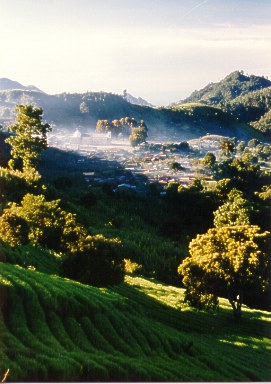 |
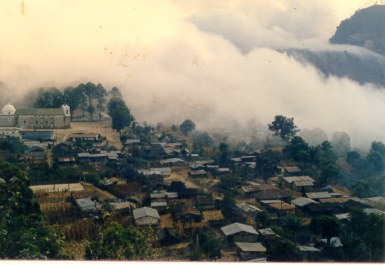
This was the town of Santa Catarina
Ixtahuacan in the Department of Solola.
Presently it has been mostly abandoned after
large landslides during hurricane Mitch. Its
located at about 7500 ft altitude in the steep
mountains descending from the western
highlands to the southern coastal plain. On
clear days you can see the Ocean in the
distance, but most afternoons thick clouds
rolled in as in the above picture. |
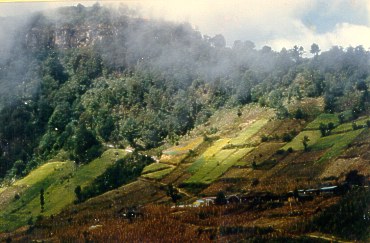
Santa Catarina covers a big area and is almost
all just very sloped ground. It is made up of
town and many smaller communities in the
hills called aldeas. The area I worked in
varied from Xeabaj above at above 10,000 ft.
Altitude to Tzanchaj to the right at an altitude
of around 3,500 ft. I was walking about 100
km a week to get to these aldeas. |
 |
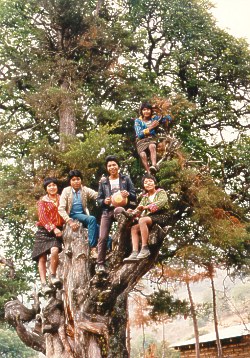 |
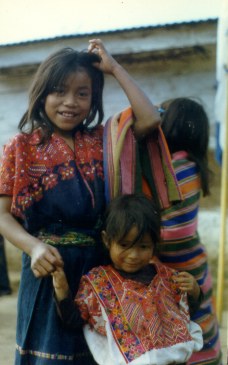 |
| Local Boys |
Local Girls |
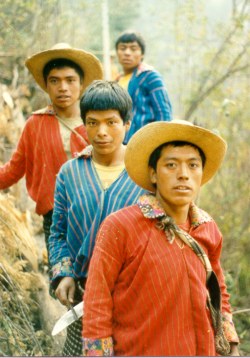
|
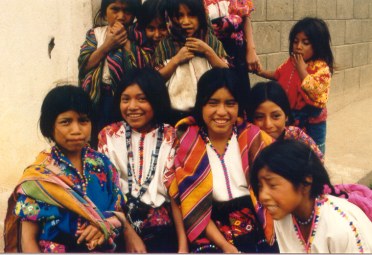
The traditional dress is very colorful in Santa
Maria Ixtahuacan. This tradition is being
steadily lost among the men, but preserved
among the women. The men traditionally
wear a wool kilt fastened by a woven belt.
Their shirts are colorful striped with designs
woven in on the cuffs and collar. Women
wear an indigo skirt fastened by a woven belt
and a blouse that is traditionally white with
some mostly red patterns woven into the
fabric, but younger girls use almost every
color available. A woven square of cloth used
for most every use finishes it off. |
 |
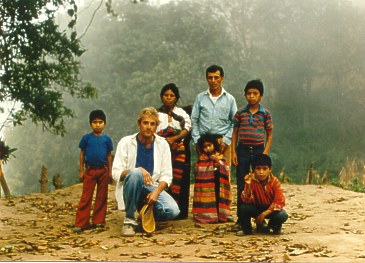 |
| Here I am in the local dress or traje. |
Me with a local family in the village of
Chuisibel. |
 |
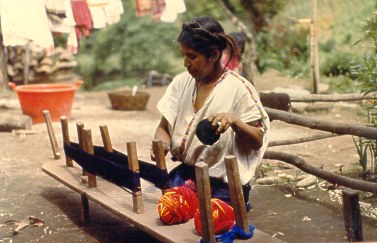 |
| Weaving is a significant activity for the
women. Thread was spun from cotton grown
on the coast traditionally including naturally
brown cotton. Machine made thread is more
commonly used nowdays. |
This lady is measuring out thread for the weft
for a shirt. They take measurements with
thread and knot it at the length needed. The
thread is wound around the sticks to form the
length and the width is formed by the number
of windings. It is then soaked in corn starch
for strength. |
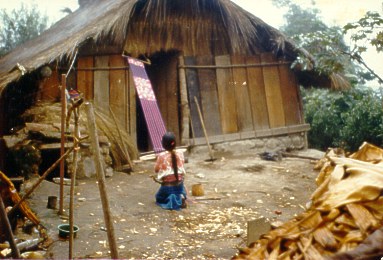 |
 |
| A backstrap loam goes back to the days of the
Maya. The measured threads seen above or
weft are stretched between two sticks and
arranged in order. A string is wound around
every other thread so when pulled it separates
the weft in half. Another thread is passed
between the alternating threads to form the
warp and make the cloth. |
In Santa Catarina Ixtahuacan designs are
woven into the cloth as its being woven. This
is called brocading. The designs have
symbolic meanings and most of the patterns
have been used for many years. Their are
many animals and geometric patterns like the
one for earthquakes on the top of the blouse
above. |
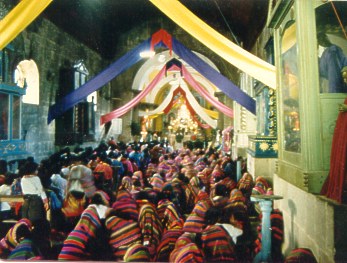 |
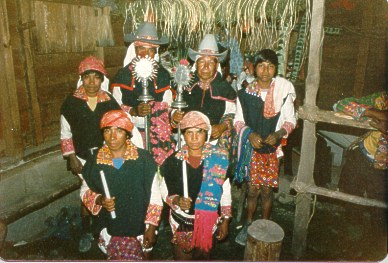 |
| The chruch is a central point for many people
in this community and the old colonial period
chruch is decorated with saint statues and a
silver altar piece. The men and the women sit
on opposite sides. |
The Cofradias are secret societies that carry
out the functions and protect the chruch.
They are comprised of older members and
new novices from the various communities in
the Santa Catarina township. |
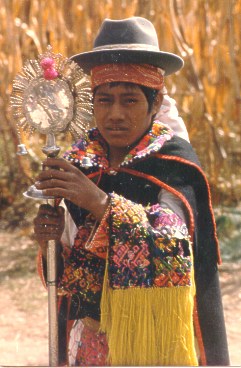 |
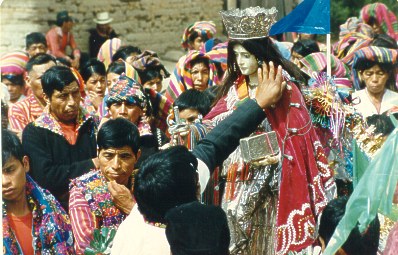
Cofradia members have a very specific dress
they wear as well as these silver staffs for the
positions of rank. The cofradia members
organize all the processions though town that
honor the varios saints, especially the patron
saint of the town - Santa Catarina de
Alejandria. The processions honor various
saints, act out the life of christ and carry the
baby Jesus to the outlying communities after
christmas. |
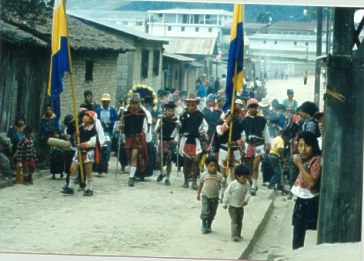 |
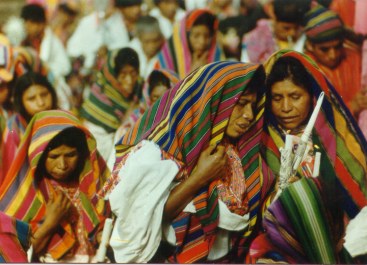 |
| Procession though town |
Women members of the cofradia |


|

Easter is a big time for processions that act
out the passion play. Above a procession of
Jesus bearing his cross. To the left is Judas or San
Simon hanging himself. Judas has special magical meaning among indigenous people of Guatemala. Women having trouble getting pregnant
try to run under him while hanged while the cofradia members keep them away. Townspeople build these aches during easter
for the processions to go though. There is
also special bread and food made by all during
this time. |
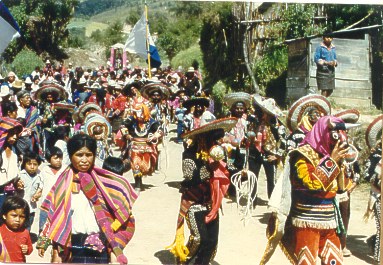 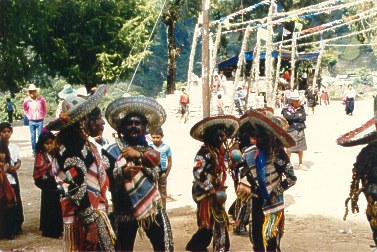
|
 |
| During holidays traditional dances with their
origins in the Spanish colonial period are
performed. |
Young dancer on a popsicle break |
 |
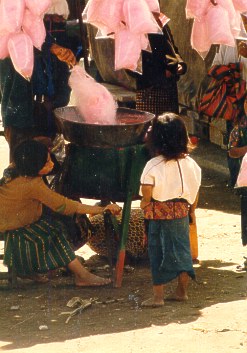 |
| Church bells during celebrations |
Cotton candy , sweets, dances and a big
market are also part of every celebration |
 |
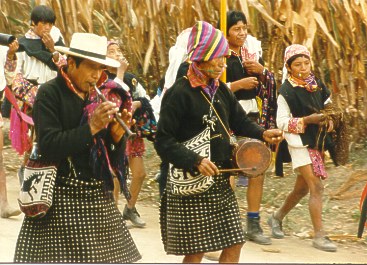
People best colors are on display during
celebrations as seen to the left. Traditional
music consists of a flute like chiminea and a
drum. Also there is more modern marimba
band music far into the night. The costs come
from richer members of the community who
are giving away some of their good luck back
to the community. Mayan folklore holds that
good luck is limited so if one gets too much
there are ways to spread it out to avoid evil. |
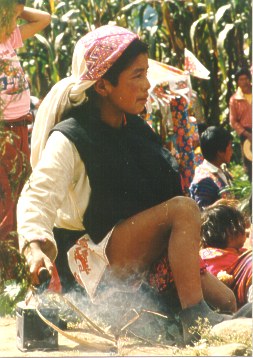 |
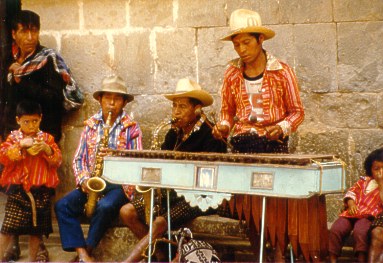
Marimba and horn band. This is a simplier
local band. For the big parties and dances
outside bands are hired with marimbas and
horns, but also sound systems and good
singers. To the left is a member of the
cofradia with coals for the incense burner
being kept in an iron for clothes. |
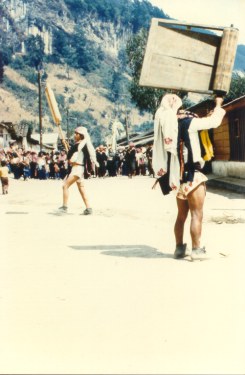 |
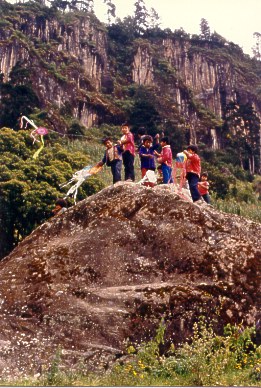 |
| These noisemakers used during Easter sound
like thunder in the distance. |
Kites are flown during the day of the dead or
all saints day. |
 |
 |
| Making adobes from mud and straw to make
bricks for houses |
Beekeeping for honey. This got more difficult
with africanized bees came in during the 80's |
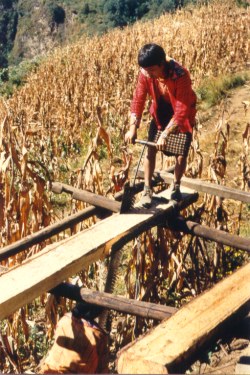 |
 |
| Sawing up boards for houses. Deforestation
was managable until chains saws came into
use in the 90's and when outside rich
businesses were able to buy large amounts of trees. |
Subsistance living means you make or trade
for almost everything since very little cash
income can be had. This boy is making a
basket. |
 |
 |
| Making bread in these big clay ovens heated
with firewood produces really good bread. |
On some market days fresh meat was
available. The cows were butchered on
banana leaves near my house early in the
morning on market day. |
 |
 |
| Children are carried everywhere when they are
young on peoples backs with a square of
cloth. It seams to make them feel very secure. |
Coffee beans being separated from their
berries. The beans are then dried and roasted.
Coffee is only grown in the lower elevations
of Ixtahuacan like the village of Tzamchaj. |
 |
 |
| Raising chickens is a very important source of
protein in many places for the meat and eggs
they produce. Chickens are very self
sufficient and hardy animals to raise. |
Market place stand that sells the raw cotton,
wool and synthetic thread and cloth that is
used in weaving. The saleswoman is from
Totonicapan. |
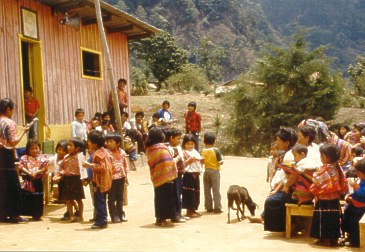 |
 |
| Small community school in one of the villages. This is during a presentation for parents. |
Making the road into town by hand which
didn't exist when I first arrived. Each community had to volunteer labor for a rotating week. |
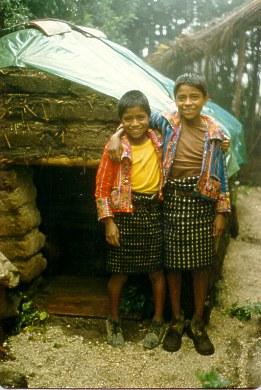 |
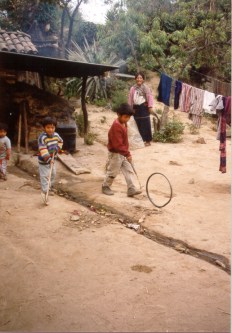 |
| In front of a tamascal which is a steam bath.
These are really nice and leave you really
warm and clean. A fire heats up rocks inside, then the fire is removed. You go in and pour water on the hot rocks
to produce steam. Then you get washed up with hot water in basins inside. |
Rolling around a wheel with a stick is a
common play activity it seams everywhere. |
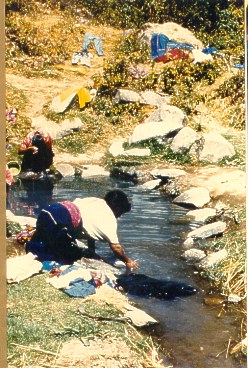 |
 |
| Washing clothes at a spring. |
Local kids |
 |
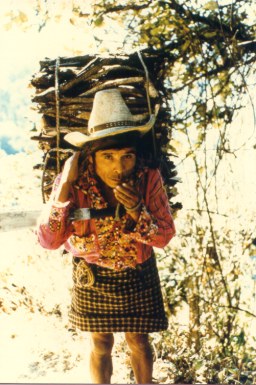 |
| Cows are raised for meat mostly and serve as
a bank for some families. As long as the cow
doesn't die, its value increases over time and
its value is independent of inflation. |
Firewood for cooking comes from the
surrounding mountains and is carried in on
ones back along narrow paths. Carrying
heavy weights with a headstrap might look
uncomfortable, but its very effective and easy
on ones back. |
 |
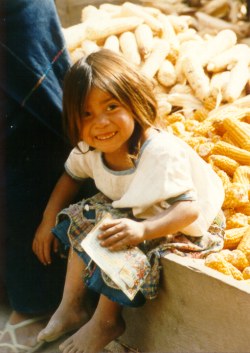 |
| Harvest of corn and melons. Corn seed is
selected and hung on the post. Corn is grown in many colors from yellow to black. |
Everyone is involved in the harvest from
bringing it in to cleaning and selecting cobs. |
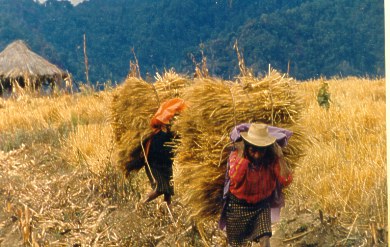 |
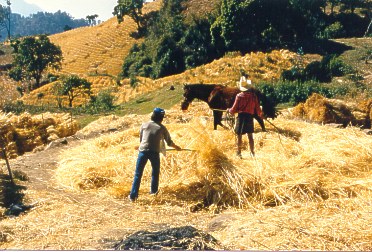 |
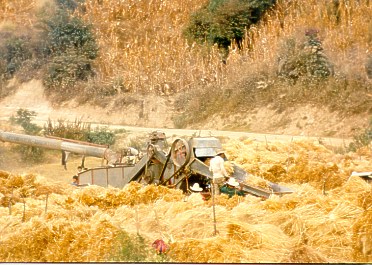 |
Wheat is grown in the highlands for making
bread and because at high altitudes corn does
produce as well. Ripe wheat is cut by hand in
the field and brought to a threshing location.
It is them threshed by walking a horse over
the wheat and winnowing the grain in the
wind, or the "modern way" using these old
threshing machines. |
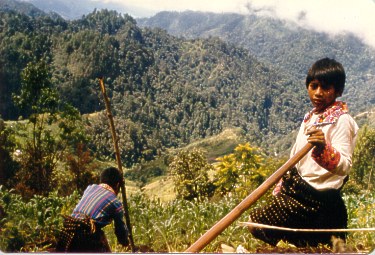
Weeding corn grown on the hillsides. There
are great views almost everywhere in
Ixtahuacan since the topography is so hilly.
To the right a man is spraying Cauliflower for
sale in the bigger cities. These cash crops are
important sources of income and the seconds are eaten locally. |
 |
 |

Sheep are raised for the wool for clothing.
The black and white wool are both in demand.
Goats are for milk. To the left is watercress
production grown in cascading pools of running water. |
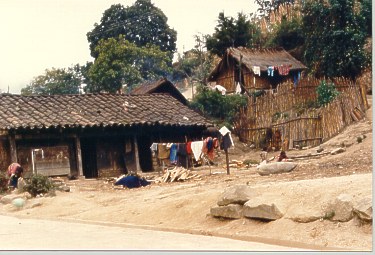 |
 |
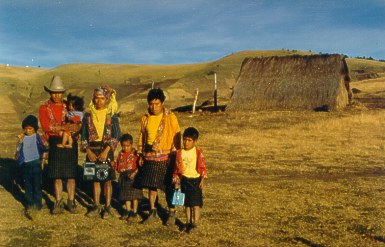 |
Houses vary a lot in Ixtahuacan from the
cement and board houses, adobe houses like
the one above to the common village house of
balsa wood boards or corn cobs and thatch
roof. To the left is a grass house up on top of
the highlands where grasslands make other
materials hard to find. |
 |
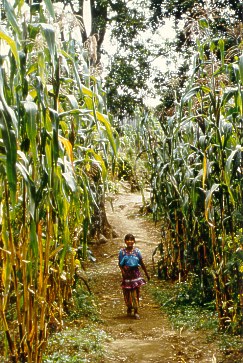 |
| Girl at her window |
Some of those tall corn stalks good for house
walls or fences |
 |
 |
| Making tortillas. Corn is present at every
meal, but not always tortillas like other rural
parts of Guatemala. The highland corn used is
more mealy and tortillas don't always puff
apart when cooking. |
Steaming tamales. Tamales can be fancy filled
with meat and sauce for special occasions or
simple corn "sticks". These simple corn only
tamalitos are the most common corn item at
meals in Ixtahuacan. |
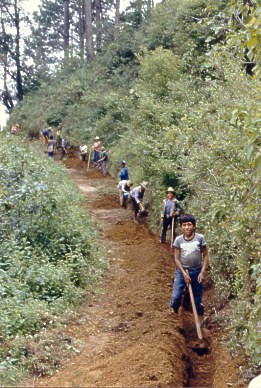 |
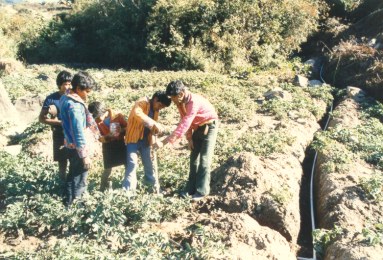
I was involved in a number of water projects
in different villages for both drinking water
and small scale irrigation. These were finaced
with US aid and local money. The water
tubers were all buried by hand and all
materials including cement carried in on
peoples back for miles up and down steep
trails. Here are pictures of projects being built
and completion ceremonies. |
 |
 |
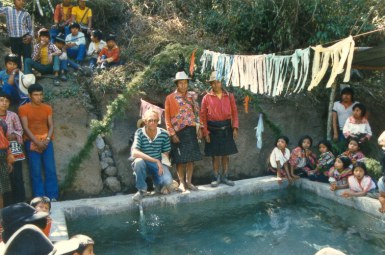 |
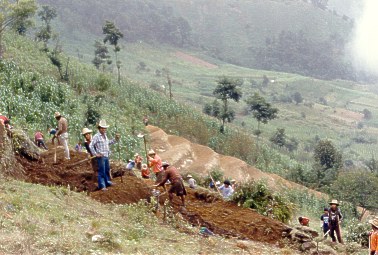 |
| A hot spring pool project |
Terracing project |
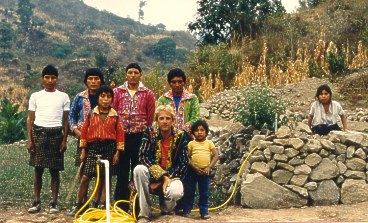
Another small scale irrigation project near the
town. These had water pipes going under
peoples fields and a water faucet at the field.
Hoses and small sprinklers irrigated the crops.
These were used mostly to produce
vegetables as a cash crop. The area was
small, but the cash they could generate really
made a difference. To the right we are
surveying an area to put in a water supply
pipe for a community. Often we had to pipe
in water across long distances across very
difficult terrain. |
 |
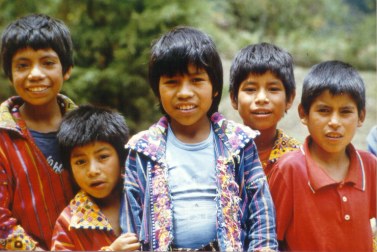 |
 |
| People of the village of Chusibel, one where |
I worked a lot. |
 |
 |
| When you take a picture of a family they want
all their best in the picture. |
Local boys from the Xeabay village way up
high in the hills. |
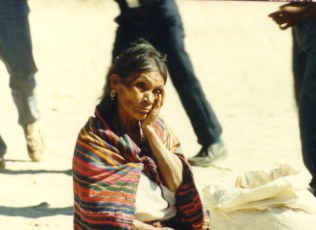 |
 |
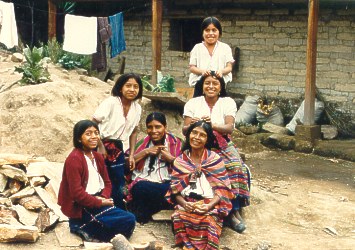 |
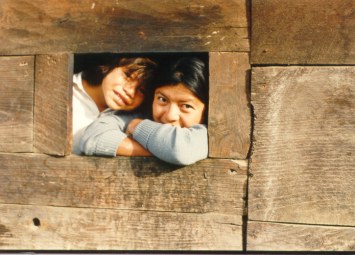 |
| More pictures of local people in the |
community. |
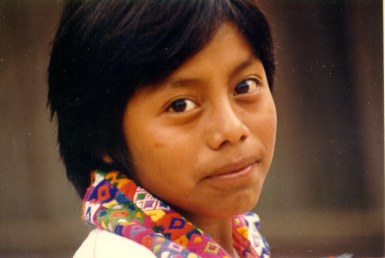 |
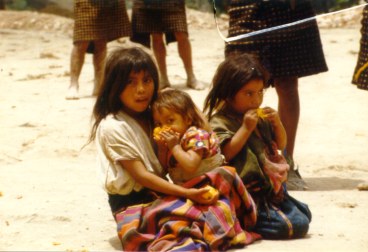 |
 |
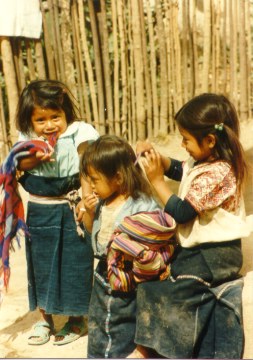 |
 |
Juan Tepaz. One of the towns wise men. The
town had a normal official government like
every other town, but their was a parallel
government of the wise men of all the
communities. The official mayor was thown
out right before I came for going against the
views of these wise men. When something
important needed to be discussed a meeting of
all the town and village older accepted men
and some women was called. |
























































































